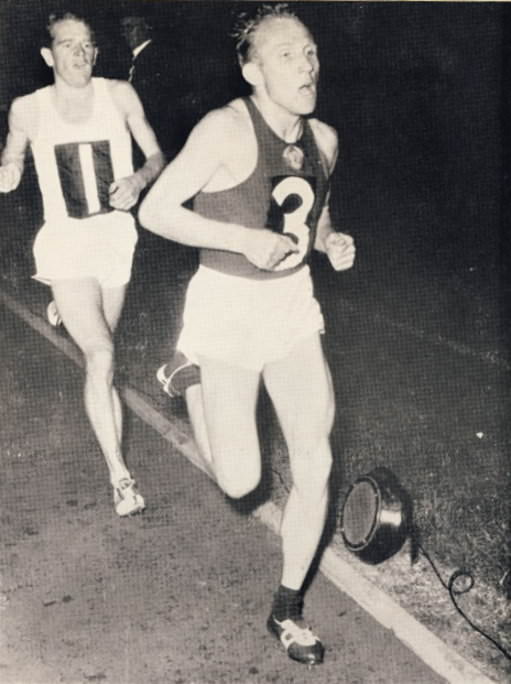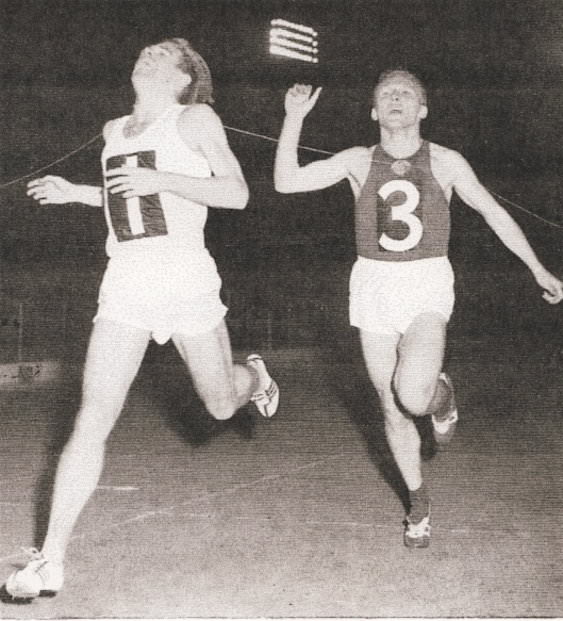Chataway v Kuts
5,000: KUTS V. CHATAWAY
LONDON, 13 OCTOBER 1954
Great Races # 10
This famous 5,000 race took place during an international meet between London and Moscow at the White City Stadium in London. It was the first visit by a Russian team since 1878. These were the days before floodlights were developed, when movable spotlights, set up on the stadium roof, were used to highlight the runners in the gloomy evening.
It was another classic front-runner-versus-kicker race. WR-holder Kuts (27) knew he had to run away from Chataway (23); Chataway knew he had to hold on to Kuts throughout and rely on his faster finish. Kuts had already shown that he was able to use pace variation to good effect; this, apart from a pure fast pace, is often the front-runner’s best weapon. And Chataway, of course, knew he would have to deal with this pace-variation tactic, having just been defeated by Kuts a few weeks before in the European Championships.
There was another crucial difference between these two great runners. Kuts was probably training harder than anyone else in the history of running—or at least as hard as his biggest influence, Zatopek. Under his coach, Nikiforov, he had been driven to limits of human endurance. Chataway on the other hand was a gentleman runner who, despite his high ambitions, worked full-time for the Guinness organization, trained only 35 miles a week and even smoked. It seemed that Chataway would have to make a superhuman effort to beat this Russian running machine. This was really a race between an amateur and a professional.
 |
| Chataway hanging on: "My oxygen debt was horrendous." |
After the European Championships, Chataway, believing his season was over, had participated in a two-week training camp on Salisbury Plain to complete national-service military commitments. This “training” apparently involved a lot of socializing and late nights—but no running. When he returned home from Salisbury Plain, he found a letter offering him the chance to race Kuts again in a month’s time. He accepted and went back to training—over the sand dunes near Poole.
On October 13, after a lot of pre-race publicity—“Thisaway, thataway, he went Chataway” was one headline—four runners lined up under the White City spotlights for the 5,000: Kuts and Okorokov of Moscow and Chataway and Driver of London. There was a huge crowd of 40,000 and an estimated 10 million viewers on the new Eurovision television network.
Kuts went straight into the lead, reeling off laps of 62.8, 67.0, 65.8, and 68.8. The first mile was in 4:24.4, almost five seconds ahead of Kuts’s pace in his 13:56.6 WR. All four runners were still together. At this point Kuts put in a withering sprint that left Chataway 15 yards in his wake. But the Englishman responded and soon caught up again as Kuts eased off. A 62.4 lap. “He threw in these bursts that I had not come across before,” Chataway recalled. “No one ran like that.” (David Thurlow, Track Stats 43:3, p.7)
Kuts continued to make bursts over the next three laps, but Chataway always matched him: 69.0, 70.0, 69.6. Kuts clocked 8:54.8 at two miles. The two deadlocked runners, etched out by the spotlights, were now well ahead of the two other runners.
 |
| The desperate finish. Kuts is raising his arm in victory. Was he surprised by Chataway? |
The race continued in the same way: 69.6, 69.4 (67.6 in T&FN), 69.0. Since the first three laps of the race, the lap times had been amazingly consistent—despite Kuts’s brutal surges. The time at the bell was 12:51.4, with Chataway still attached to the Russian. Kuts increased the pace; Chataway stayed with him. They passed three miles in 13:27.0 and 13:27.1. Was Chataway’s willpower strong enough to withstand the relentless pace of Kuts? “My oxygen debt was horrendous,” Chataway recalled 50 years later. “By the time I was entering the final straight, it was really like throwing oneself over the cliffs. My legs had the capacity to accelerate despite the fact that my lungs were crying out for relief.” (Thurlow, p.7)
Here’s how Norris McWhirter described the end of the race: “As if impelled by the roar of the delirious crowd, Chataway switched over to the super-human. With sheer savagery he struck late but decisively, and with consummate if desperate timing surged past his quarry five tantalizing yards before he could claim the asylum of the tape.” The times were 13:51.6 and 13:51.8, both inside Kuts’s WR. Chataway had run his last lap 0.3 of a second faster than Kuts to win.
“I had almost given up in the final two laps,” Chataway admitted later. “I felt I was deceiving myself by continuing to run at this pace and keeping with him. I was actually not thinking I was going to win until the last stride or two.” (Thurlow, p. 7) He has called his victory “the most extravagant race I have ever run” and “the most painful quarter-of-an-hour of my life.”
1. Chataway 13:51.6; 2. Kuts 13:51.8; 3. Driver 14:29.2 4. Okorokov 14:50.
Footnote: Almost unnoticed in the excitement of this race was another WR: Lituyev won the 440 Hurdles in 51.3. (He was already the 400H WR-holder with 50.4.) 
7 Comments